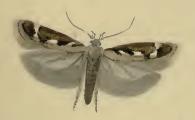
Elachista argentella is a moth of the family Elachistidae found in all of Europe, except the Balkan Peninsula.

Prays fraxinella, the ash bud moth, is a moth of the family Plutellidae. It is found in Europe.

Simyra albovenosa, the reed dagger, is a moth of the family Noctuidae. It is found in most of Europe, then Turkey, Iran, Transcaucasus and into the east Palearctic.

Stigmella lapponica is a moth of the family Nepticulidae found in Asia, Europe and North America. It was first described by the German entomologist, Maximilian Ferdinand Wocke in 1862. The larvae mine the leaves of birch.

Stigmella cypracma is a species of moth in the family Nepticulidae. It is endemic to New Zealand. The larvae of this species are leaf miners and pupate with their mines. The host species is Brachyglottis repanda. The adult moths are on the wing in February and September to November.

Coleophora lixella is a moth of the family Coleophoridae found in most of Europe. It was first described by Philipp Christoph Zeller in 1849.

Elachista adscitella is a moth of the family Elachistidae found in Europe.

Elachista albifrontella is a moth of the family Elachistidae found in Europe.

Elachista obliquella is a moth of the family Elachistidae found in Europe.
Elachista epimicta is a moth of the family Elachistidae. It is found in Alberta, Alberta, British Columbia, Manitoba, Saskatchewan, Colorado, Illinois, Ohio and South Dakota.

Caryocolum marmorea is a moth of the family Gelechiidae. It is found from Scandinavia to the Mediterranean islands, and from Ireland to Poland, Hungary and Greece. It is also found on the Canary Islands and Madeira. It is also found in North America.

Aproaerema anthyllidella is a moth of the family Gelechiidae. It is found in most of Europe, Kyrgyzstan, Iran and North America.

Scrobipalpa samadensis, the buck's-horn groundling, is a moth of the family Gelechiidae. It is found in most of Europe and Russia.
Bucculatrix agnella is a species of moth in the family Bucculatricidae. The species was first described by James Brackenridge Clemens in 1860. It is found in North America, where it has been recorded in Pennsylvania, New Jersey, New York, Washington D.C., Massachusetts, Indiana, Tennessee, Kentucky, Michigan, Missouri, South Dakota, Maine, Ohio and Texas.
Elachista praelineata is a moth of the family Elachistidae. It is found in the United States, where it has been recorded from Ohio. The habitat consists of dry hillside woods.

Elachista illectella is a moth of the family Elachistidae. It is found in North America, where it has been recorded from Arizona, Illinois, Indiana, Kentucky, Maine, Mississippi, Ohio, Oklahoma, Ontario, Tennessee, Texas and West Virginia. The habitat consists of deciduous forests.

Eudonia zophochlaena is a moth in the family Crambidae. It was described by Edward Meyrick in 1923. It is endemic to New Zealand. It has been hypothesised that this species is a North Island endemic. The adults of this species are on the wing from December until February. The larvae of this species are leaf miners of the leather-leaf fern Pyrrosia eleagnifolia.

Helcystogramma hystricella, the lanceolate helcystogramma moth, is a moth in the family Gelechiidae. It is found in the United States, where it has been recorded from Minnesota to Pennsylvania, south to Maryland and Kentucky, west to Oklahoma and Kansas.
Elachista kobomugi is a moth in the family Elachistidae. It was described by Sugisima in 1999. It is found in Japan on the islands of Hokkaido and Honshu.

Kessleria orobiae is a moth of the family Yponomeutidae. It is found only in the Orobian Alps in the Bergamo Province in Italy. The habitat consists of rocky areas on calcareous and siliceous soil.













